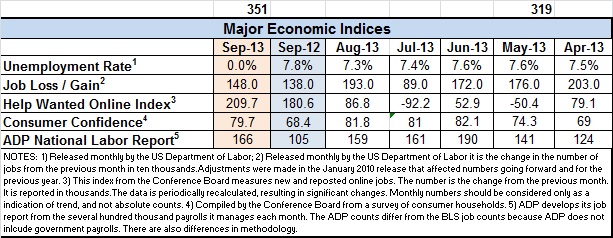As far as September’s jobs news is concerned, it might have been better if the government shutdown cancelled the report altogether.
Instead, the U.S. Department of Labor‘s delayed report released this morning showed the U.S. economy added 148,000 jobs in September while the unemployment rate inched down to 7.2 percent.
Economists were expecting the report to show an increase of about 180,000 jobs.MarketWatch economists were expecting an even-more-robust 185,000. No change was predicted from August’s 7.3 stronger unemployment rate.
The government also adjusted numbers for August and July, resulting in a July gain of only 89,000 jobs, the weakest showing in a year. However, with August’s upward revision of 24,000 jobs, the net gain comes to 9,000.
Economy is still struggling
Overall, the report paints a picture of an economy still struggling to pick up steam. Hiring in the first two quarters of the years averaged 195,000 new monthly jobs. In the third quarter, the average was 143,000. Although hiring seasonally slows in summer, last year the third-quarter hiring averaged 152,000 jobs.
September’s job growth may have been hampered slightly by the looming government shutdown, though economists expect the total impact to be small and mostly short-lived. October’s report, which, like the September report, will also be delayed, is where the impact will show up.
 Today’s report would originally have been released Oct. 4, but the government shutdown that week furloughed most of the U.S. Bureau of Labor Statistics employees, including those who prepare the report. There is an upside, which is that the report may be more accurate because in a typical month only about 70 percent of the employers surveyed return their reports in time to be included in the monthly release.
Today’s report would originally have been released Oct. 4, but the government shutdown that week furloughed most of the U.S. Bureau of Labor Statistics employees, including those who prepare the report. There is an upside, which is that the report may be more accurate because in a typical month only about 70 percent of the employers surveyed return their reports in time to be included in the monthly release.
October’s employment report, scheduled for release on November 1, will now be released the following Friday.
September’s report shows some of the biggest jobs gains came from teacher hiring, which increased by 19,800 jobs as school got underway across the nation. Another strong area were those gearing up for the holiday shopping season, especially in wholesale and logistics.
Where jobs were added
The biggest gainers in September:
- Retail added 20,800 workers, including 4,200 jobs in auto sales;
- Wholesale trade added 16,100 jobs;
- The transportation and warehousing sector grew by 23,400 jobs, with the biggest gain coming in transit and ground passenger transportation;
- Construction, driven by growth in residential building, added 20,000;
- Temp hiring increased 20,200.
Overall, 13.6% out of work or underutilized
September had few particularly big losers, though the leisure and hospitality sector dropped 13,000 workers, mostly in accommodations and food service, a consequence of the end of summer vacations.
The non-durable goods component of the manufacturing sector lost 7,000 jobs, but were offset by a 9,000 increase in the durable goods component. Non-durable goods include such things as paper and food manufacturing, textiles, and chemicals.
The number of unemployed workers and those who are out of work and want a job but have stopped looking, didn’t change in September. There were 11.3 million workers officially counted as unemployed during the month. Another 2.3 million fall into the out of work, but stopped looking category. Some 7.9 million more are working part-time because they had their hours cut or can’t find full-time work.
In total, the Labor Department says 13.6 percent of the labor force is out of work or involuntarily underutilized (working part-time).
